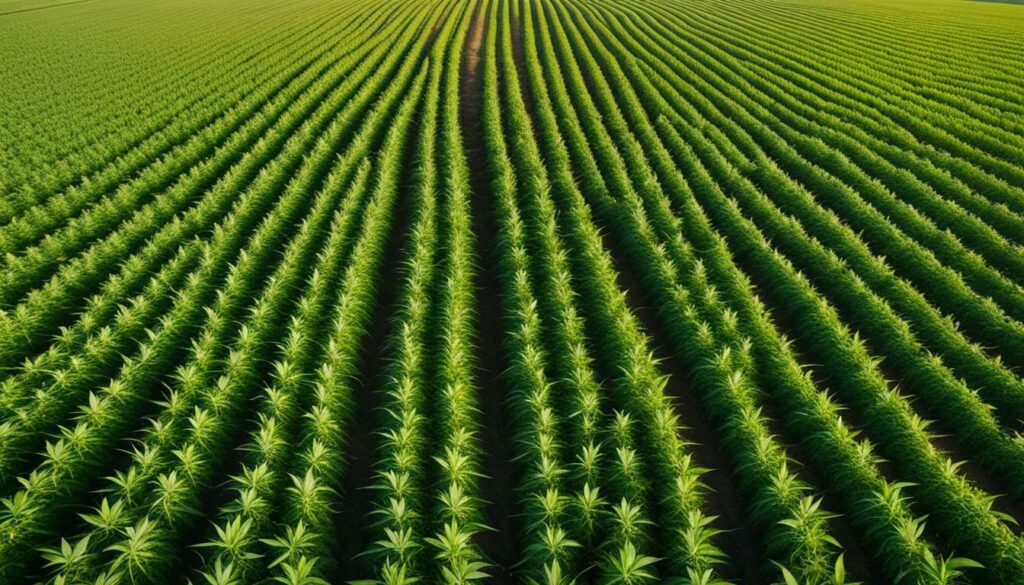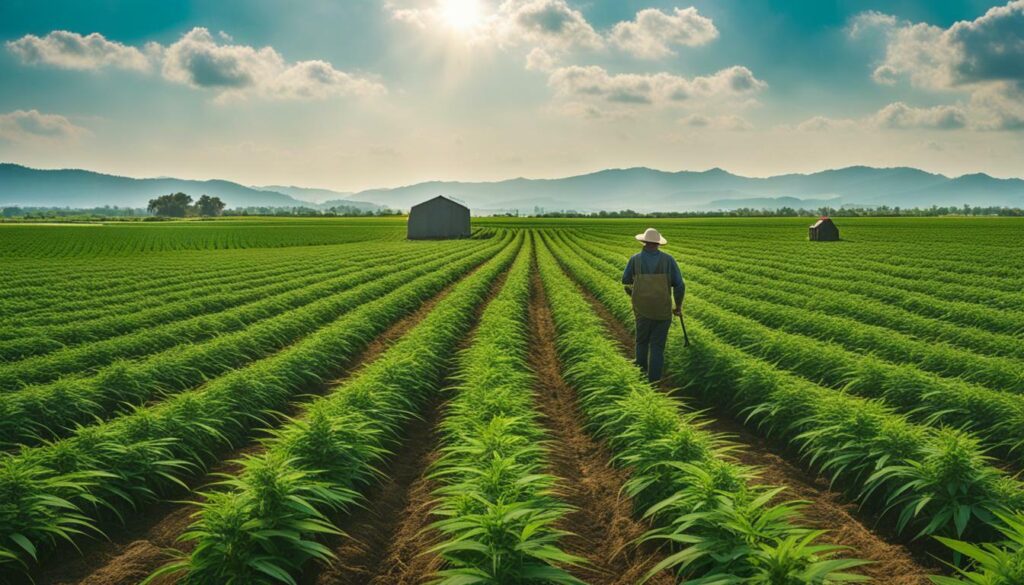Hemp is Used for Textiles
The use of hemp fibers in the textile industry has gained popularity as a sustainable alternative for clothing production.
Hemp, a versatile plant known for its strength and durability, offers numerous benefits when used to create textiles.

One of the key advantages of hemp fibers is their eco-friendly nature.
Hemp is a fast-growing plant that requires minimal water, pesticides, and fertilizers, making it a sustainable choice for textile production.
Additionally, hemp is biodegradable, reducing the environmental impact of clothing waste.
Hemp fibers are known for their strength and durability, making them ideal for creating long-lasting clothing.
When woven into fabrics, hemp fibers have excellent breathability and temperature regulation properties, ensuring comfort in various weather conditions.
Hemp’s Sustainable Fashion Potential: Hemp’s Role in the Fashion Industry
Hemp’s use in the fashion industry extends beyond clothing. It can also be used to produce accessories, such as handbags, wallets, and shoes.
Fashion brands can promote a more sustainable and eco-conscious image by incorporating hemp into their collections.
| Hemp Textiles Benefits: | Key Points: |
|---|---|
| Durable | Hemp fibers are known for their strength and longevity. |
| Sustainable | Requires minimal water, pesticides, and fertilizers in cultivation. |
| Biodegradable | Hemp clothing is environmentally friendly and reduces landfill waste. |
| Breathable | Provides excellent airflow and temperature regulation. |
“Hemp fibers offer a sustainable alternative to conventional textiles, providing durability, breathability, and environmental benefits.”
As the fashion industry continues to explore sustainable practices, hemp has emerged as a viable option for clothing and accessory production.
Hemp’s versatility, durability, and eco-friendly attributes make it a valuable resource in pursuing a more sustainable future.
Nutritional Benefits: Hemp in the Kitchen
Hemp seeds and oil offer a range of nutritional benefits, making them a popular choice in the kitchen for health-conscious individuals.
Packed with protein, hemp seeds are a complete source of essential amino acids, making them an excellent plant-based protein option for vegans and vegetarians.
Just three tablespoons of hemp seeds provide approximately 10 grams of protein and important minerals like iron, magnesium, and zinc.
Hemp seeds are rich in healthy fats, particularly omega-3 and omega-6 fatty acids.
These essential fats play a vital role in brain health, heart health, and reducing inflammation. Incorporating hemp seeds into your diet can help support a healthy cardiovascular system and contribute to overall well-being.
Hemp oil, derived from the hemp plant seeds, is another versatile ingredient with numerous health benefits.
It is a great source of polyunsaturated fats, including omega-3 and omega-6 fatty acids known for their anti-inflammatory properties.
Hemp oil’s nutty flavor makes it a delicious addition to dressings, sauces, and smoothies.

Here are some key benefits of incorporating hemp seeds and oil into your diet:
- High-quality protein: Hemp seeds are a complete source of protein, containing all nine essential amino acids. They are an excellent option for those following a plant-based diet.
- Healthy fats: Hemp seeds and oil are rich in omega-3 and omega-6 fatty acids, which promote heart health, reduce inflammation, and support brain function.
- Mineral-rich: Hemp seeds are a good source of essential minerals, including iron, magnesium, zinc, and phosphorus.
- Versatile ingredient: Hemp oil can be used in a variety of dishes, from salad dressings to baked goods, adding a nutty flavor and nutritional benefits.
With their wealth of nutrients, hemp seeds and oil are a valuable addition to any health-conscious kitchen and fitness plan.
Whether you sprinkle hemp seeds on your morning oatmeal or use hemp oil in your favorite recipes, you’ll reap the benefits of these nutritious powerhouses.
| Nutritional Information: | Hemp Seeds (3 tablespoons) | Hemp Oil (1 tablespoon) |
|---|---|---|
| Protein | 10g | – |
| Omega-3 Fatty Acids | 2.8g | 1.5g |
| Omega-6 Fatty Acids | 7.5g | 5.0g |
| Iron | 2.4mg | – |
| Magnesium | 210mg | – |
| Zinc | 3.9mg | – |
Biofuel: Hemp as an Environmentally-Friendly Energy Source
Hemp holds promise as a sustainable biofuel, offering an environmentally-friendly alternative to fossil fuels.
With its fast growth cycle and high carbon capture capabilities, hemp has the potential to reduce carbon emissions and combat climate change significantly.
Hemp is a highly efficient crop, requiring minimal water and pesticides compared to other biofuel sources.
Hemp biomass can be converted into biofuel through various processes, including fermentation and pyrolysis. The resulting biofuel can be used in various applications such as transportation, heating, and electricity generation.
Not only does hemp biofuel emit fewer greenhouse gas emissions compared to fossil fuels, but it also has the potential to improve air quality due to its low sulfur content.
To illustrate the potential of hemp biofuel, consider the following table that compares the carbon emissions of hemp biofuel with traditional fossil fuels:
| Fuel | Carbon Emissions (kg CO2 per liter) |
|---|---|
| Hemp Biofuel | 1.5 |
| Petroleum Diesel | 2.7 |
| Gasoline | 2.3 |
As demonstrated in the table, hemp biofuel emits significantly less carbon dioxide compared to petroleum diesel and gasoline, making it a cleaner and more sustainable energy option.
Furthermore, hemp biofuel can be produced domestically, reducing dependence on imported fossil fuels and enhancing energy security.
Research suggests hemp is twice as effective as trees at absorbing and locking up carbon, with 1 hectare (2.5 acres) of hemp reckoned to absorb 8 to 22 tonnes of CO2 a year, more than any woodland.
From the Guardian:
With ongoing research and advancements in hemp cultivation and biofuel production techniques, the potential of hemp as a sustainable energy source continues to expand.
By harnessing the power of hemp biofuel, we can make significant strides towards a greener and more sustainable future.

“Hemp biofuel has the potential to revolutionize the energy industry. Its sustainability, carbon capture capabilities, and low emissions make it a promising alternative to fossil fuels.”
Building Materials: Hemp’s Role in Sustainable Construction
Hemp-based building materials offer a sustainable solution for the construction industry, providing eco-friendly alternatives to traditional materials.
Hemp fibers, known for their strength and durability, can create a wide range of construction materials, including insulation, concrete-like blocks, and composite panels.
One of the key advantages of hemp-based building materials is their low environmental impact. Unlike traditional materials such as concrete and steel, hemp has a significantly lower carbon footprint.
Hemp plants absorb large amounts of carbon dioxide during their growth, making them an excellent carbon sequestration tool.
Hemp cultivation requires less water and pesticides than other crops, making it a more sustainable choice.
Insulation is one area where hemp excels as a building material.
Hemp insulation is made from the plant’s woody fibers, providing excellent thermal and acoustic properties. It is also breathable, mold-resistant, and non-toxic, making it a healthier option for buildings.
Furthermore, hemp insulation is easy to install, reducing construction time and costs.
In addition to insulation, hempcrete is gaining popularity as a sustainable alternative to concrete.
Hempcrete is made by mixing hemp hurds (the inner woody core of the plant) with lime and water.
The resulting material is lightweight, insulating, and breathable. It also has excellent moisture regulation properties, preventing the buildup of moisture and reducing the risk of mold and rot.
| Advantages of Hemp-based Building Materials |
|---|
| Low carbon footprint |
| Good thermal and acoustic properties |
| Breathable and mold-resistant |
| Easy to install |
| Excellent moisture regulation |
Hemp-based building materials are sustainable and offer superior performance compared to traditional materials. Their strength, durability, and insulating properties make them a versatile choice for a wide range of construction applications.
As the demand for more eco-friendly alternatives continues to grow, hemp is poised to play a significant role in shaping the future of sustainable construction.

Hemp’s ability to sequester carbon and its potential in nanotechnology make it a valuable resource for sustainable practices. As a plant, hemp is known for its efficient photosynthesis process, converting carbon dioxide into oxygen and capturing atmospheric carbon in its biomass.
This natural carbon capture ability makes hemp effective in combating climate change and reducing greenhouse gas emissions.
Furthermore, hemp’s potential in nanotechnology opens up exciting possibilities for various industries.
Nanotechnology involves manipulating materials at the molecular and atomic level, allowing for developing new and innovative products.
Due to their unique structure and properties, hemp fibers can be used in nanotechnology applications such as drug delivery systems, sensors, and filtration systems.

For example, hemp-based nanomaterials can be used to create efficient water filtration systems, removing contaminants and pollutants from water sources.
This technology has the potential to provide clean drinking water to communities in need while minimizing the use of harmful chemicals often associated with conventional filtration methods.
The use of hemp in nanotechnology can contribute to the development of sustainable packaging materials, reducing dependence on single-use plastics and promoting a circular economy.
However, further research is needed to fully unlock the potential of hemp in carbon sequestration and nanotechnology. T
he historical prohibition of hemp has limited scientific investigation, but efforts are underway to understand its genetic diversity and develop high-yielding varieties suitable for different applications.
By investing in research and innovation, we can harness the power of hemp to create a more sustainable future, addressing climate change and promoting environmentally-friendly alternatives.
Agriculture and Cultivation: Understanding Hemp’s Growth
Hemp cultivation practices and ongoing research efforts aim to understand its genetic diversity and maximize its potential yield. With its versatility and sustainability, hemp has gained significant attention as a promising crop for various industries. From textiles to biofuels, hemp offers environmentally-friendly alternatives that can help reduce the impact on our planet.
Genetic diversity plays a crucial role in developing high-yielding hemp varieties suitable for different climates and growing conditions. Researchers are working diligently to unlock the full potential of hemp by studying its genetic makeup and identifying traits that contribute to enhanced productivity and quality.
One of the key advantages of hemp cultivation is its relative tolerance to heat and its ability to thrive in diverse soil types. This adaptability makes it an attractive option for farmers looking to cultivate a sustainable and profitable crop.
To illustrate the potential of hemp cultivation, research conducted by the Hemp Industries Association found that hemp can produce up to 250% more fiber than cotton and 600% more fiber than flax, using the same land area. This impressive yield demonstrates the efficiency and productivity of hemp as a fiber crop.

Furthermore, hemp is known for its carbon capture capabilities, making it an essential crop for mitigating climate change. The fast-growing nature of hemp allows it to absorb large amounts of carbon dioxide from the atmosphere, helping to reduce greenhouse gas emissions.
| Cultivation Benefits | Genetic Diversity | High-Yielding Varieties |
|---|---|---|
| Heat tolerance | Enhanced productivity | Increased fiber yield |
| Adaptability to different soils | Improved quality | Sustainable crop |
| Carbon capture | Climate change mitigation |
Animal Bedding and Insulation: Hemp’s Versatile Applications
Hemp’s versatility extends to animal bedding and insulation applications, providing sustainable alternatives to conventional materials.
Using hemp in animal bedding benefits the animals and contributes to a more eco-friendly approach. Hemp bedding is highly absorbent, helping maintain clean and comfortable animal conditions.
When used as insulation material, hemp offers numerous advantages. Its natural fibers provide excellent thermal insulation, keeping buildings cool in the summer and warm in the winter.
Hemp insulation is breathable, preventing moisture buildup and reducing the risk of mold and mildew.
The sustainability of hemp as an animal bedding and insulation material cannot be overstated. Hemp is a renewable resource that requires minimal chemical use during cultivation, making it an ideal choice for those seeking environmentally-friendly options.
By choosing hemp-based animal bedding and insulation materials, individuals can contribute to a greener future.

- Hemp bedding is highly absorbent, providing clean and comfortable conditions for animals.
- Hemp insulation offers excellent thermal properties, keeping buildings energy-efficient.
- Hemp insulation is breathable, reducing the risk of mold and mildew.
- Hemp is a renewable resource and requires minimal chemical use during cultivation.
“Hemp’s versatility in animal bedding and insulation provides sustainable alternatives to conventional materials.”
| Advantages | Animal Bedding | Insulation |
|---|---|---|
| Excellent Absorbency | ✓ | – |
| Thermal Insulation | – | ✓ |
| Breathable | – | ✓ |
| Renewable Resource | ✓ | ✓ |
Research and Potential: Unlocking Hemp’s Full Potential
Despite historical prohibition, hemp research is gaining momentum, unlocking its full potential for environmentally friendly alternatives and promoting soil health. With its versatile applications and sustainable qualities, hemp holds great promise in various industries.
Hemp’s potential as a sustainable alternative to materials like plastic and concrete is being explored. Researchers are investigating its use in biofuel production, which could significantly reduce carbon emissions and pave the way for a greener future. Additionally, hemp’s ability to capture and store carbon makes it an attractive option for carbon sequestration projects, contributing to mitigating climate change.
In the construction industry, hemp is emerging as a viable option for building materials and insulation.
Hemps natural fibers provide excellent insulation properties and can help reduce energy consumption in buildings.
Hemp cultivation practices promote soil health by reducing the need for harmful pesticides and herbicides, making it an environmentally friendly choice.

Research efforts are focused on understanding hemp’s genetic diversity and developing high-yielding varieties. By selecting and breeding plants with desirable traits, scientists aim to improve crop productivity and enhance its economic viability on a larger scale. This research is crucial for unlocking the full potential of hemp as a sustainable resource.
| Key Benefits of Hemp | Applications |
|---|---|
| Environmentally-friendly | – Textiles |
| Sustainable | – Nutritional Products |
| Carbon Capture | – Biofuel |
| Promotes Soil Health | – Construction |
| Versatile | – Animal Bedding |
| – Insulation |
The potential of hemp goes far beyond its current applications. Ongoing research and development will continue to uncover new possibilities for this remarkable plant, offering alternatives that are not only sustainable but also beneficial for the environment and human health.
In Summary: Harnessing the Power of Hemp
Hemp’s versatility and potential as an environmentally friendly resource make it valuable in promoting sustainable alternatives across various industries.
From textiles to biofuels and from construction to nanotechnology, hemp’s numerous applications highlight its ability to contribute to a greener future.
One of the key advantages of hemp lies in its ability to produce durable and sustainable textiles.
The strong and resilient fibers derived from hemp make it an ideal choice for clothing that can withstand wear and tear while reducing the environmental impact.
Its eco-friendly qualities, such as being pesticide-free and requiring fewer resources for cultivation, make hemp an attractive choice for conscious fashion brands.
The nutritional benefits of hemp cannot be understated. Hemp seeds are packed with protein, making them an excellent addition to a balanced diet.
Hemp oil provides a healthy alternative for cooking, with its high omega-3 fatty acid content. Incorporating hemp into our kitchens supports our well-being and reduces our reliance on less sustainable food sources.
Furthermore, hemp’s potential as a biofuel cannot be overlooked. As an environmentally-friendly alternative to fossil fuels, hemp offers a sustainable solution for reducing carbon emissions. Its fast growth and ability to capture carbon make it an attractive option for biofuel production, helping to combat climate change and promote a cleaner energy future.
In sustainable construction, hemp’s role in providing building materials and insulation cannot be underestimated.
Hemp-based construction materials offer a renewable and low-carbon alternative to traditional materials like concrete and plastic.
By reducing the ecological footprint of the construction industry, hemp contributes to creating more energy-efficient and environmentally-friendly buildings.
Aside from its applications in textiles, nutrition, biofuels, and construction, hemp also holds promise in carbon sequestration and nanotechnology.
Hemps ability to capture and store carbon and its potential use in nanotechnology opens up possibilities for sustainable solutions in various industries, including agriculture, healthcare, and electronics.
However, it is important to acknowledge that historical prohibition has hampered hemp research. Efforts are being made to understand the plant’s genetic diversity and develop high-yielding varieties suitable for different applications.
Unlocking hemp’s full potential requires continued research and innovation, paving the way for a more sustainable and eco-friendly future.
Finally, hemp offers a plethora of environmentally-friendly alternatives across industries. Its versatility, sustainability, and potential make it a valuable resource in our quest for a greener and more sustainable world.
By embracing the power of hemp, we can reduce our environmental impact, promote sustainable practices, and cultivate a brighter future for generations to come.
FAQ
Q: What are the uses of hemp in the textile industry?
A: Hemp fibers are used to create durable and sustainable clothing, offering eco-friendly alternatives to traditional textiles.
Q: What are the nutritional benefits of hemp?
A: Hemp seeds are high in protein, and hemp oil can be used in cooking, making it a healthy addition to a balanced diet.
Q: How can hemp be used as a biofuel?
A: Hemp can be used as an environmentally-friendly alternative to fossil fuels, reducing carbon emissions and promoting sustainability.
Q: How does hemp contribute to sustainable construction?
A: Hemp can be used as building materials and insulation, reducing environmental impact in the construction industry.
Q: What is the potential of hemp in carbon sequestration and nanotechnology?
A: Hemp can capture and store carbon, and it has applications in nanotechnology for various industries.
Q: What are the cultivation practices and genetic diversity of hemp?
A: Ongoing research aims to develop high-yielding varieties of hemp, while understanding its genetic diversity and cultivation requirements.
Q: How is hemp used in animal bedding and insulation materials?
A: Hemp offers eco-friendly alternatives to traditional materials in animal bedding and insulation, benefiting both animals and the environment.
Q: What are the challenges and potential of hemp research?
A: Hemp research has lagged due to historical prohibition, but efforts are being made to explore its potential in providing environmentally-friendly alternatives and benefiting soil health and water conservation.
Q: What is the overall potential of hemp as a sustainable resource?
A: Hemp has the potential to offer environmentally friendly alternatives in various industries, promoting sustainability and benefiting the environment.

0 Comments